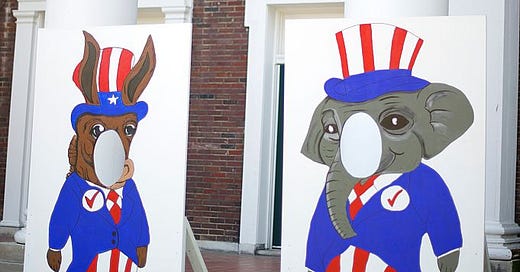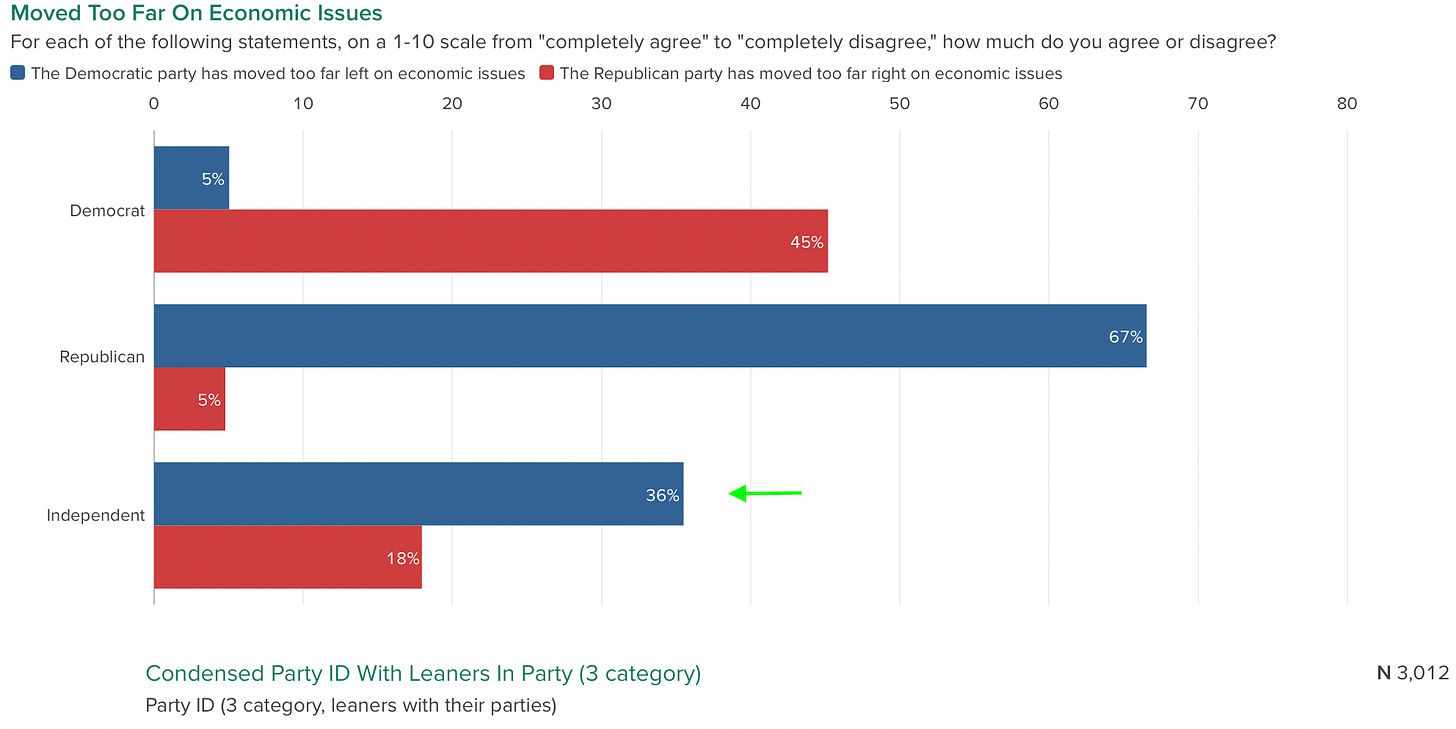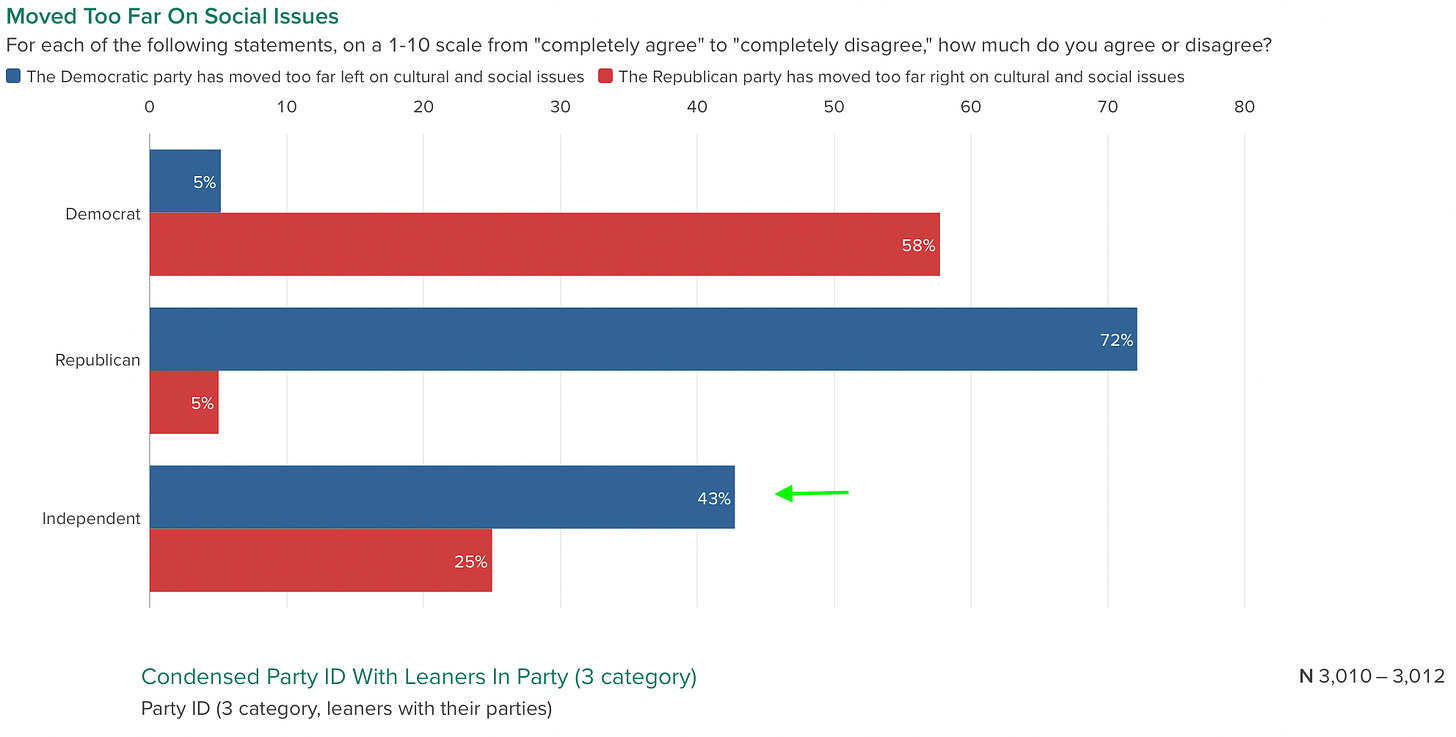The Damaged Brands of America’s Two Political Parties
Majorities of voters believe Democrats and Republicans are too extreme on both economic and cultural issues.
Continuing our examination of the first wave of polling in the new TLP/YouGov 2024 presidential tracking project, we find sobering data for both Democrats and Republicans in terms of their respective political brands. Simple story: most American voters believe both parties have become too ideologically extreme in terms of economic and cultural issues.
The survey asked respondents to rate each party individually on a ‘1-10’ scale, from completely agree to completely disagree, on two dimensions: “The Democratic Party has moved too far left on economic issues/cultural and social issues,” and “The Republican Party has moved too far right on economic issues/cultural and social issues.”
As seen in the charts below (measured as the total percentage reporting a ‘1-5’ and ‘6-10’ in each question), majorities of American voters agree that Democrats have moved too far left, and that Republicans have moved too far right, on both economic and cultural issues.
Democrats receive slightly worse marks than Republicans in both areas. For example, 56 percent of voters think Democrats have moved too far left on economic issues compared to 51 percent of voters who think Republicans have moved too far right. Likewise, 58 percent of voters think Democrats have moved too far left on cultural and social issues compared to 54 percent who think Republicans have moved too far right on these issues.
In terms of partisan breakdowns, GOP voters generally hold harsher opinions of Democrats than vice versa. Looking at the proportion of partisan identifiers who say they completely agree that the other party has moved too far left or right (measured as a ‘1’ on each scale), roughly 7 in 10 Republicans say they completely agree that Democrats have moved too far left on both economic and cultural issues. In comparison, only 45 percent Democrats completely agree that Republicans have moved too far right on economics with 58 percent of Democrats feeling that way about the GOP on social issues. Strict independents—those who do not lean towards one party or another—break heavily against Democrats in terms of perceived ideological extremism on both dimensions, thus producing the slightly worse ratings for Democrats overall.
Interesting education splits emerge as well. For example, six in 10 non-college educated voters overall say that Democrats have moved too far left on economic issues versus 48 percent who say Republicans have moved too far right. Conversely, 55 percent of college educated voters say Republicans have moved too far right on economics while 51 percent believe Democrats have moved too far left.
As highlighted in the charts below, similar patterns are seen on the social front with substantially more non-college voters viewing Democrats as extreme on cultural issues (60 percent agree Democrats are extreme; 49 percent agree Republicans are extreme) and more college educated ones feeling that way about Republicans (62 percent agree Republicans are extreme; 54 percent agree Democrats are extreme).
These findings should serve as a wake-up call to the two major parties. American voters by-and-large think that both Democrats and Republicans have become too ideologically extreme for their tastes. Yet the current dynamics within both parties suggest that left- and right-wing factions will continue to hold sway over party brands—to their mutual detriment.
As mentioned in an earlier post, the saving grace for Democrats in the 2024 cycle is that President Biden currently outperforms both his party and Donald Trump on several key dimensions—most importantly, on perceptions of which leader is closer to voters in terms of “being culturally moderate and not extreme” where Biden leads Trump by a 10-point margin (45 percent to 35 percent) and outperforms Democrats on this measure by 6 points (45 percent vs 39 percent).
Given the damaged brands of both Democrats and Republicans—and the relatively stronger personal brand of Joe Biden versus Donald Trump—Republican primary voters will need to think long and hard about which candidate they put up in 2024. President Biden, in turn, will need to put his more moderate stamp on a party that is increasingly perceived to be out of the mainstream.
These decisions may determine victory or defeat in a close election in which many voters despise both parties equally.











